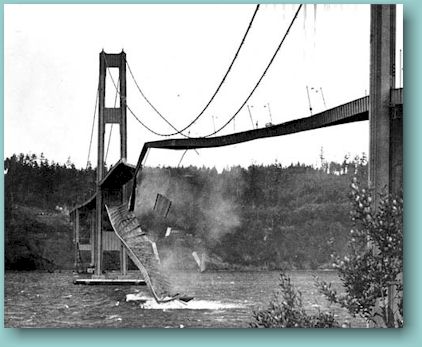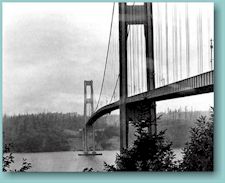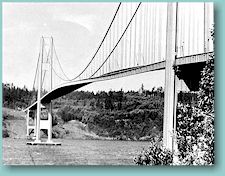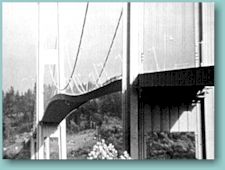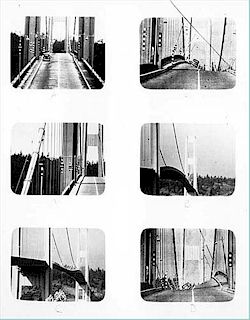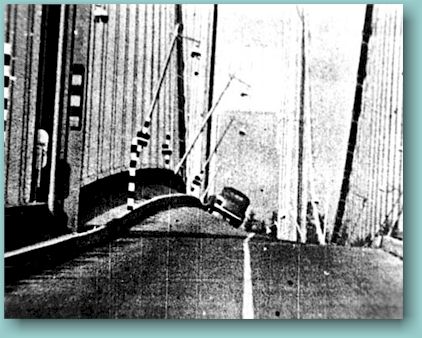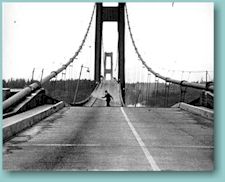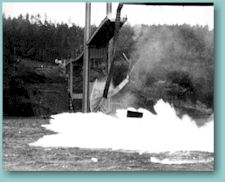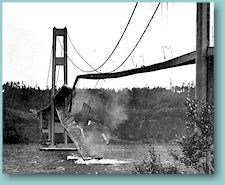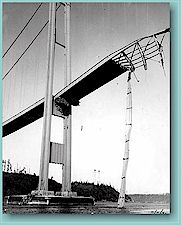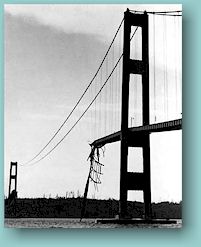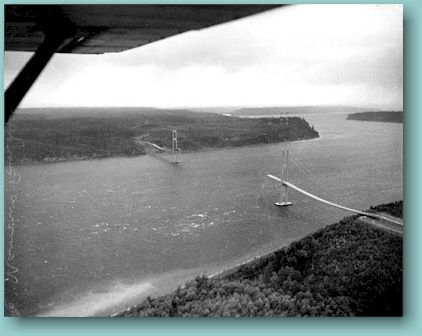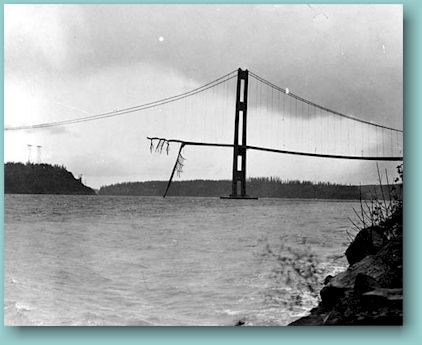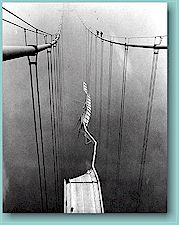The Collapse
History of the Tacoma Narrows Bridge
|
|
Pt. 4: The Collapse
The following images and text detail the collapse of Tacoma Narrows Bridge. Links to further pages on the Introduction, Opening, Construction, Aftermath, and Reconstruction are available at the bottom of the page. Text sources are listed in the bibliography at the end of the Reconstruction section. Image sources are described in the captions accompanying the images. The images are the exclusive right of the cited institutions (the University of Washington Libraries Special Collections Division and the Museum of History and Industry), please contact them for reproduction permission.
For additional images and documents relating to the history of the Tacoma Narrows Bridge, see the Tacoma Narrows Bridge Collection on the UW Libraries Digital Collections website.
|
|
The collapse of the Tacoma Narrows Bridge occurred at approximately 11:00 AM on November 7, 1940 under the action of a wind approximately 42 mph. Witnesses to the fall were numerous reporters, engineers and onlookers. A dog trapped in an abandoned car on the bridge was the only fatality.
|
|
|
The bridge had begun to move in its usual fashion (a vertical motion similar in feeling to a roller coaster ride) by 9:45 that morning. As usual many were gathered to watch, walk, or drive the bridge. A college student named Winfield Brown walked across the rippling bridge and was on his way back across. Professor Farquharson was at mid-span, there to film the bridge for the final preparation on the deflect shield design that was to minimize its movement.
|
|
|
|
|
|
A Tacoma reporter, Leonard Coatsworth, and his dog were driving slowly across the bridge. A man and woman in a logging truck lumbered along as well.
At approximately 10:15 the bridge began twisting laterally in addition to the vertical waves. Coatsworth's car was forced to the curb.
Abandoning his car, Coatsworth walked and crawled with Brown off the pitching bridge. Farquharson went ashore for more film and then returned to the bridge.
The couple in the logging truck scrambled off. Farquharson, noticing the abandoned dog, tried to rescue the animal but was bitten and decided to leave it alone. As the bridge began to buckle Farquharson moved toward shore.
|
"A few minutes later I saw a side girder bulge out on the Gig Harbor side, due to a failure, but though the bridge was buckling up at an angle of 45 degrees the concrete didn't break up. Even then, I thought the bridge would be able to fight it out. Looking toward the Gig Harbor end, I saw the suspenders -- vertical steel cables -- snap off and a whole section of the bridge caved in. The main cable over that part of the bridge, freed of its weight, tightened like a bow string, flinging suspenders into the air like so many fish lines. I realized the rest of the main span of the bridge was going so I started for the Tacoma end." (Farquharson, F.B. "Bridge Fell From Under Me, Professor Says." Columbus Evening Dispatch, November 8, 1940) |
|
|
|
|
|
|
|
|
Slideshow |
|
[Show image] Midsection of the Tacoma Narrows Bridge collapsing as viewed from the shore, November 7, 1940. PH Coll. 290.41 University of Washington Libraries. Special Collections Division. |
|
[Show image] Side girder of the Tacoma Narrows Bridge rising and falling during collapse as viewed from the shore, November 7, 1940. PH Coll. 290.44 University of Washington Libraries. Manuscripts, Special Collections, University Archives Division. |
|
[Show image] Side girder rising and falling during Tacoma Narrows Bridge collapse as viewed from the shore, November 7, 1940. PH Coll. 290.43 University of Washington Libraries. Manuscripts, Special Collections, University Archives Division. |
|
[Show image] Side girder whipping up during the Tacoma Narrows Bridge collapse, November 7, 1940. PH Coll. 290.40 University of Washington Libraries. Special Collections Division. |
|
|
After the first section fell, the lateral twisting ceased briefly only to resume in the main span and the approaches. The failure progressed along the bridge, the shock of each successive collapse on the main span producing a corresponding shock in the approaching spans. Finally the approaches sagged, lost all of their lateral motion and came to relative rest. The main towers and approaches remained but were severely damaged.
|
|
Plans to rebuild were discussed immediately but it would not be until 1950 that the Tacoma Narrows was again spanned.
|
|
|
|
|
